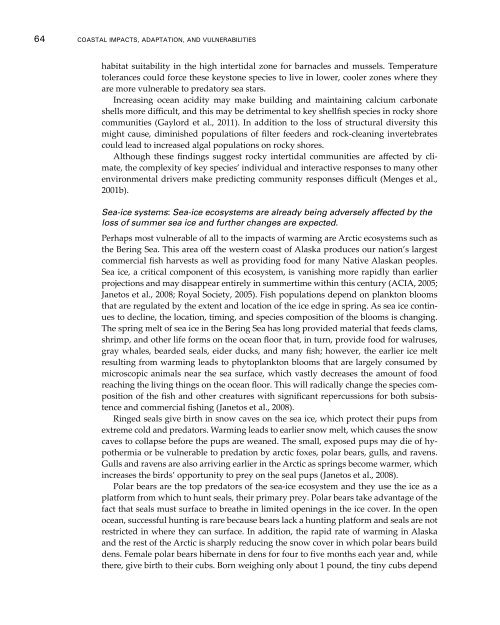Coastal Impacts, Adaptation, and Vulnerabilities - Climate ...
Coastal Impacts, Adaptation, and Vulnerabilities - Climate ...
Coastal Impacts, Adaptation, and Vulnerabilities - Climate ...
You also want an ePaper? Increase the reach of your titles
YUMPU automatically turns print PDFs into web optimized ePapers that Google loves.
64 <strong>Coastal</strong> <strong>Impacts</strong>, <strong>Adaptation</strong>, <strong>and</strong> <strong>Vulnerabilities</strong>habitat suitability in the high intertidal zone for barnacles <strong>and</strong> mussels. Temperaturetolerances could force these keystone species to live in lower, cooler zones where theyare more vulnerable to predatory sea stars.Increasing ocean acidity may make building <strong>and</strong> maintaining calcium carbonateshells more difficult, <strong>and</strong> this may be detrimental to key shellfish species in rocky shorecommunities (Gaylord et al., 2011). In addition to the loss of structural diversity thismight cause, diminished populations of filter feeders <strong>and</strong> rock-cleaning invertebratescould lead to increased algal populations on rocky shores.Although these findings suggest rocky intertidal communities are affected by climate,the complexity of key species’ individual <strong>and</strong> interactive responses to many otherenvironmental drivers make predicting community responses difficult (Menges et al.,2001b).Sea-ice systems: Sea-ice ecosystems are already being adversely affected by theloss of summer sea ice <strong>and</strong> further changes are expected.Perhaps most vulnerable of all to the impacts of warming are Arctic ecosystems such asthe Bering Sea. This area off the western coast of Alaska produces our nation’s largestcommercial fish harvests as well as providing food for many Native Alaskan peoples.Sea ice, a critical component of this ecosystem, is vanishing more rapidly than earlierprojections <strong>and</strong> may disappear entirely in summertime within this century (ACIA, 2005;Janetos et al., 2008; Royal Society, 2005). Fish populations depend on plankton bloomsthat are regulated by the extent <strong>and</strong> location of the ice edge in spring. As sea ice continuesto decline, the location, timing, <strong>and</strong> species composition of the blooms is changing.The spring melt of sea ice in the Bering Sea has long provided material that feeds clams,shrimp, <strong>and</strong> other life forms on the ocean floor that, in turn, provide food for walruses,gray whales, bearded seals, eider ducks, <strong>and</strong> many fish; however, the earlier ice meltresulting from warming leads to phytoplankton blooms that are largely consumed bymicroscopic animals near the sea surface, which vastly decreases the amount of foodreaching the living things on the ocean floor. This will radically change the species compositionof the fish <strong>and</strong> other creatures with significant repercussions for both subsistence<strong>and</strong> commercial fishing (Janetos et al., 2008).Ringed seals give birth in snow caves on the sea ice, which protect their pups fromextreme cold <strong>and</strong> predators. Warming leads to earlier snow melt, which causes the snowcaves to collapse before the pups are weaned. The small, exposed pups may die of hypothermiaor be vulnerable to predation by arctic foxes, polar bears, gulls, <strong>and</strong> ravens.Gulls <strong>and</strong> ravens are also arriving earlier in the Arctic as springs become warmer, whichincreases the birds’ opportunity to prey on the seal pups (Janetos et al., 2008).Polar bears are the top predators of the sea-ice ecosystem <strong>and</strong> they use the ice as aplatform from which to hunt seals, their primary prey. Polar bears take advantage of thefact that seals must surface to breathe in limited openings in the ice cover. In the openocean, successful hunting is rare because bears lack a hunting platform <strong>and</strong> seals are notrestricted in where they can surface. In addition, the rapid rate of warming in Alaska<strong>and</strong> the rest of the Arctic is sharply reducing the snow cover in which polar bears builddens. Female polar bears hibernate in dens for four to five months each year <strong>and</strong>, whilethere, give birth to their cubs. Born weighing only about 1 pound, the tiny cubs depend
















